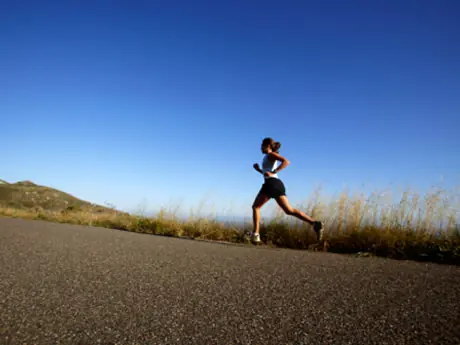
Once you get in a running groove, it's natural to want to go farther and get faster. But if you're a newbie, you might not know where to begin. The good news is that there are plenty of simple things you can do to improve your speed. If you're ready to set some PRs (that's personal records, in runner speak!), try one or all the following tips.
Practice Good Form
Focus on staying tall, relaxing your shoulders and swinging your arms so that your hands just barely brush your hips. You want to avoid crossing your arms over your body as that wastes energy. And if possible, try to land on your mid-foot (vs. your heel) while practicing light, quick steps. Looking for some guidance? Watch a video of elite runners to get an idea of what good form looks like.
Get Stronger (and Avoid Injury) With Core Work
When your core is strong, you'll be more stable during each and every stride. And the core isn't just your abs, it also includes your back and glutes. Get started with some easy body weight exercises, such as planks, bird dogs and glute bridges.
Find Some Hills
Some runners call hills "speed work in disguise" and for good reason! Hill sprints have a ton of benefits, including injury prevention, improved running economy and a more efficient use of fast-twitch muscle fibers. Find a hill that takes about a minute to run and practice charging up at a reasonably hard pace. Jog down and repeat six to eight times.
Slow Down
Wait a second; isn't this supposed to be an article about getting faster? Well, hear us out... If you're trying to improve your speed, there should be a fairly large difference between your easy pace days and your hard days. Many runners make the mistake of running all their runs at a sort-of tough pace, but when you do that, you never fully recover and you're never able to give speed work your all. Here's what to do instead: Make your easy runs truly easy. You should be able to carry on a conversation (either with a running buddy or yourself!). And your hard days (speed work or races) should be truly tough. Leave it all out there!
Try Some Strides
Strides are generally pick-ups of about 100 meters. They're not an all-out sprint; rather, they're a time to focus on form and turnover. They're a great way to get started with speed work if you've never done it before. Some advanced runners will also do strides before speed workouts or races to get their legs ready to run fast.
Dabble in Speed Work
If you're new to running, jumping into tempo runs and track workouts might seem intimidating, so ease into things. Experiment with fartlek runs. Fartlek is a Swedish word for "speed play," and essentially what you do is pick a landmark in the distance (like a mailbox or a tree) and run hard until you get there. Recover for a few minutes and then do it all over again. If you're looking for something different (or are on the treadmill), try this tried and true workout: After a warm-up, run 10 x 1 minute hard followed by one minute easy.
READ THIS NEXT: A Workout for beginner Runners
Get ACTIVE on the Go


Couch to 5K®
The best way to get new runners off the couch and across the finish line of their first 5K.
Available for iOS | Android







Discuss This Article